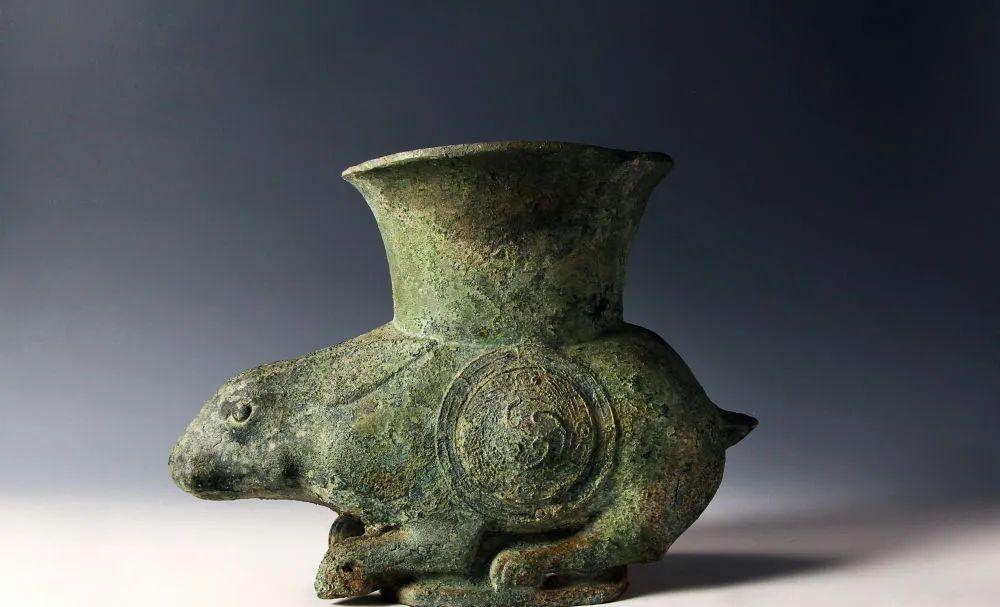
This is a bronze rabbit statue with a trumpet-shaped mouth on the back unearthed from the tomb of Jinmuhou. Photo courtesy of Jinguo Museum of Shanxi Province
In the Jinguo Museum of Shanxi Province, there are 4 rabbit statues, two large and two small, and two shapes. A large rabbit is prostrate on a short rectangular pedestal with a trumpet-shaped mouth on its back. The other big rabbit Venerable, with a rectangular mouth on its back and a lid on its mouth, its legs are curled up, its ears are brought together back, as if to jump, and the other 2 small rabbit Venerables are the same shape as it. They were unearthed in the same tomb, like a family of four.
These are three bronze rabbit statues with a rectangular mouth on the back and a lid on the mouth excavated from the tomb of Jinmuhou. Photo courtesy of Jinguo Museum of Shanxi Province
These four cute rabbit statues were unearthed in the early 90s of the 20th century in the Jinmuhou tomb of Qucun-Tianma Site, a national key cultural relic protection unit, and have a history of nearly 3,000 years. The tomb is well preserved and undisturbed, giving a true representation of the excavated relics.
Jin Muhou's father, Jin Xianhou, was not so lucky. According to archaeological data, his tomb was stolen in 1992, and 3 bronze rabbit statues survived, one with a trumpet-shaped mouth on the back, and the other two rabbit statues of the same shape and different sizes, all with rectangular openings on the back of the rabbit with a lid. This "family of three" is now in the collection of the Shanxi Museum.
This is a bronze rabbit statue with a trumpet-shaped mouth on the back excavated from the tomb of Marquis Xianhou of Jin. Photo courtesy of Jinguo Museum of Shanxi Province
"There are very few bronze rabbit statues unearthed in the mainland at present, and these 7 rabbit statues are very precious." Yuan Lifang, a staff member of the Jin Culture Research Office of the Jinguo Museum, said.
In terms of artistic image design, these 7 rabbit statues not only present the characteristics of simplicity, realism and practicality, but also have the elegant and noble aristocratic temperament of Western Zhou ritual vessels. They have concentric circles on each side of their abdomen, from the inside to the outside, the fire pattern, the oblique thunder pattern and the hook thunder pattern.
Why do the father and son of Jin Xianhou and Jin Muhou prefer Rabbit Zun? This is a question that currently has no answer, and may be related to the fact that the rabbit has a good meaning, etc.
Tian Jianwen, a researcher at the Shanxi Institute of Archaeology, said that Marquis of Jin was the seventh king of the Jin state, who was rewarded with the Zhou king's conquest, and in order to commemorate this event, a set of 16 bronze chimes was cast. After the death of Marquis Xian of Jin, not only this set of chimes was buried, but also a large number of bronze, gold, and jade, as well as the largest and most chariot pits found in the Western Zhou Dynasty and the largest number of accompanying vehicles found on the mainland, as well as the three bronze rabbit statues. His son Muhou of Jin also followed King Zhou or fought on orders from King Zhou on several occasions.
"The cultural history of mainland rabbits has a long history, and rabbits have many children and grandchildren, and the beautiful meaning of health and longevity. The ancients often incorporated the image of the rabbit into their lives, hoping to bring blessings to themselves. Yuan Lifang said.